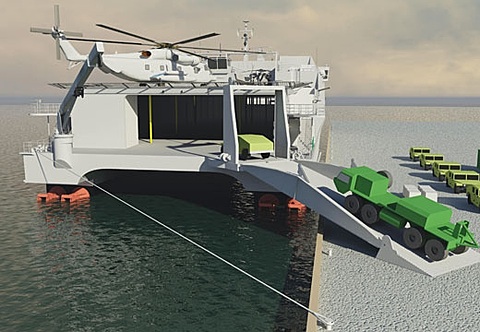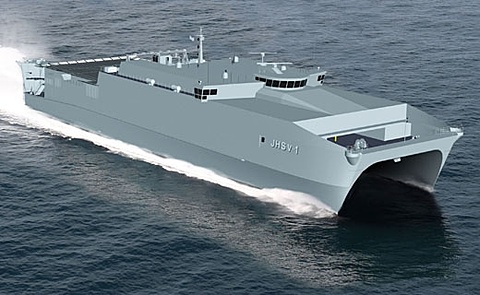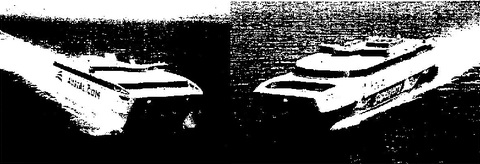www.islandbreath.org ID# 0817- 28
SUBJECT: SUPREFERRY AND DOD
SOURCE: DICK MAYER dickmayer@earthlink.net
POSTED: 15 NOVEMBER 2008 - 9:00am HST
Austal wins $1.6 billion JHSV contract

image above: Stern view ofSuperferry as JHVS with ramp loading military equipment. Who knew?
on 14 November 14 2008 in www.marinelog.com As already disclosed by Alabama U.S. Senator Richard Shelby, Austal has won the contract to design and build the U.S. Department of Defense's next generation multi-use platform, the Joint High Speed Vessel (JHSV). The Pentagon formally announced today that Austal USA, Mobile Ala., is being awarded a $185,433,564 modification to previously awarded contract (N00024-08-C-2217) for the firm quantity of one Joint High Speed Vessel (JHSV) with options for up to nine additional ships and associated shore-based spares for the Phase II downselect of the JHSV Program. The JHSV Program will provide high speed, shallow draft transportation capability to support the intra-theater maneuver of personnel, supplies and equipment for the U. S. Navy, Marine Corps, and Army. Work will be performed in Mobile, Ala., and is expected to be completed by November 2010. With the options for the nine additional vessels expected to be exercised between FY09 and FY13, the program is potentially worth over US$1.6 billion. Similar to the Austal-built "WestPac Express" operated by the US Marines for the past seven years, the JHSV will be capable of transporting troops and their equipment, supporting humanitarian relief efforts, operating in shallow waters and reaching speeds in excess of 35 knots fully loaded. The vessels will be a joint-use platform operated by both the United States Army and Navy. The JHSV will have a 103 m catamaran hull (which is actually shorter than the 113 m Hawaii SuperFerry cats built by the yard) and a speed of more than 35 knots. A draft of 3.8 m will allow superior access to "austere" ports. With a payload of 635 tonnes, its range at 35 knots will be 1,200 nautical miles. Accommodations include embarked troop berthing for 150 troops and airline style seating for 312 Troops at 5.25 ft seating pitch. The JHSV flight deck will be capable of handling the CH-53E, the largest and heaviest helicopter in the U.S. military. It will have a loading ramp arrangement capable of supporting M1A2 Abrams tanks. An open, unobstructed mission deck will offer a usable cargo area of more than 1,800 sq. meters (clear height of 4.75 m and turning diameter of 26.21 m). Propulsion power will be provided by MTU 8000 engines, as used in the LCS and Hawaii Superferry. MTU 8000 Series diesels offer the world's highest power-to-weight ratio in their power range, delivering up to 12,200 bhp (9,100 kW) of continuous power, and a fuel consumption of less than 190g/kW h. The JHSV will have an active motion control system with four control surfaces. "Being selected as prime contractor for a major U.S. Department of Defense shipbuilding program demonstrates Austal's capabilities as a defense supplier," said Austal Managing Director Bob Browning. He termed the ten vessel program "an important step in Austal's strategy to create longer-term, more predictable earnings for our investors." At Austal's Mobile shipyard, work is continuing on the first phase of a new state-of-the-art Modular Manufacturing Facility (MMF). Upon completion in mid-2009, the first half of the 70,000 square meter MMF will be available for the fabrication of all JHSV modules. Austal USA's 1,000-strong workforce will grow to more than 1,500 as a result of the JHSV program. Austal is teamed with General Dynamics Advanced Information Systems, who will design, integrate, and test the JHSV's electronic systems, including an Open Architecture Computing Infrastructure, internal and external communications, electronic navigation, aviation, and armament systems. |

image above: Superferry is only a few details and a paint job away from military duty as a JHSV
SUBJECT: SUPREFERRY AND DOD
SOURCE: JUAN WILSON juanwilson@mac.com
POSTED: 4 AUGUST 2008 - 3:30pm HST
Superferry Corporation seeks DOD contract

image above :Cover illustration on HSF proposal to DOD shows WestPac Express and Superferry Alakai
by Juan Wilson on 4 August 2008 revision 1.1 080805 I have received a PDF file from an obscured source that appears to be a proposal from the Hawaii Superferry Corporation (HSF) to the Department of Defense (DOD). Click here to download PDF 3meg file. The proposal is for the outfitting of the second Superferry (Austal hull A616), now under construction at Austal USa in Mobile, Alabama, with what it calls "National Defense Features" (NDF) that would make the new Superferry more useful to the military. The document paints a picture of a working partnership between the Superferry Corporation, Austal USa and the US Navy to coordinate the construction of civilian ferries for military use and ultimately to develop a Navy ship class that began with the Marine Third Expeditionary Force use of WestPac Express. The proposal states:
The document appears to be a second or third generation photo copy that has been scanned and converted into a PDF file before distribution. The document is dated 11 March 2008 an looks to be on Superferry Corporation stationary. Besides the cover (see detail above) the document has twelve numbered pages and three pages of illustrations. If the document is genuine, it is supporting evidence that details what the Superferry proposes to do to redesign the Superferry fleet (and future JHSV's) to meet military specifications. The primary NDF improvements are: 1) the addition of a loading ramp capable of loading a wide range of military hardware onto the vehicle deck from the stern of the vessel (like the Marine's WestPac Express in Okinawa. 2) the addition of seawater desalinization equipment for extended journeys AS to the ramp, remember that the clumsy use of barges for loadingthe Superferry were only considered because they would not constitute harbor infrastructure improvements and would therefore not trigger a lengthy Environmental Impact Statement (EIS). A genuine EIS could sink or delay the project. That would threaten the prospective loan guarantees of $150 million from the Maritime Administration (MARAD). MARAD would only fund the project if the ferries there were no encumbrances from exposure to EIS regulations and if the HSF participated in the military's Voluntary Intermodal Sealift Agreement (VISA) program that makes merchant marine ships available to the Navy. Superferry lobbies for military upgrade Lobbyists hired by Superferry approached the U.S. Congress and the U.S. Department of Defense to help pay for a vehicle ramp and other improvements. Austal submits final JHSV proposal to Navy Austal USA submitted its Phase II Joint High Speed Vessel (JHSV) proposal to the US Navy this week bringing to closure the Phase I (Preliminary Design) period. Austal was one of three bidders awarded a Phase I contract in January 2008 and it is expected that a single Phase II contract will be awarded later this year for detail design and construction of the lead JHSV with options to build up to ten ships. |
see also:
Island Breath: MARAD commitment to HSF 5/11/08
Island Breath: Fargo - Facsist at the Helm 4/26/08
Island Breath: Superferry audit shows crime 4/19/08
Island Breath: The Governor's SuperConspiracy 10/18/07
Island Breath: Superferry and the Military 10/13/06
Island Breath: Superferry Hidden Agenda 10/3/06